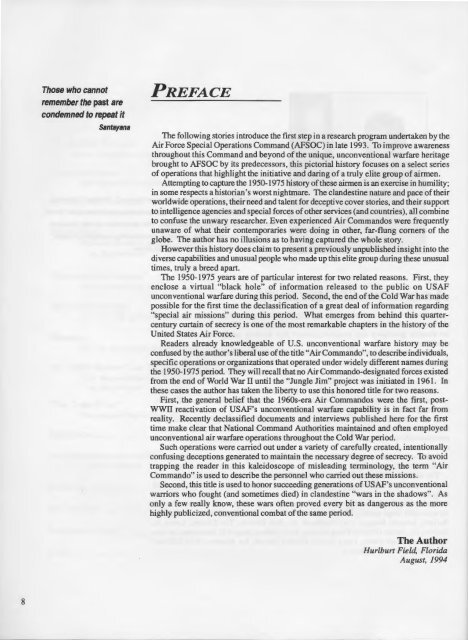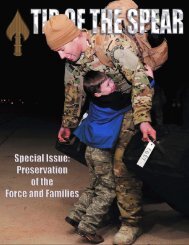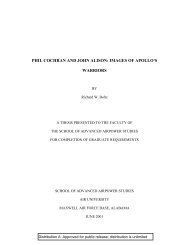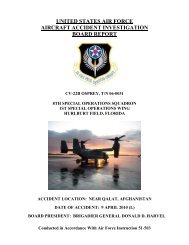Air Commando!: 1950-1975 - Twenty-five years at the Tip ... - AFSOC
Air Commando!: 1950-1975 - Twenty-five years at the Tip ... - AFSOC
Air Commando!: 1950-1975 - Twenty-five years at the Tip ... - AFSOC
You also want an ePaper? Increase the reach of your titles
YUMPU automatically turns print PDFs into web optimized ePapers that Google loves.
Those who cannot<br />
remember <strong>the</strong> past are<br />
condemned to repe<strong>at</strong> it<br />
Santayana<br />
PREFACE<br />
The following stories introduce <strong>the</strong> first step in a research program undertaken by <strong>the</strong><br />
<strong>Air</strong> Force Special Oper<strong>at</strong>ions Command (<strong>AFSOC</strong>) in l<strong>at</strong>e 1993. To improve awareness<br />
throughout this Command and beyond of <strong>the</strong> unique, unconventional warfare heritage<br />
brought to <strong>AFSOC</strong> by its predecessors, this pictorial history focuses on a select series<br />
of oper<strong>at</strong>ions th<strong>at</strong> highlight <strong>the</strong> initi<strong>at</strong>ive and daring of a truly elite group of airmen.<br />
Attempting to capture <strong>the</strong> <strong>1950</strong>-<strong>1975</strong> history of <strong>the</strong>se airmen is an exercise in humility;<br />
in some respects a historian's worst nightmare. The clandestine n<strong>at</strong>ure and pace of <strong>the</strong>ir<br />
worldwide oper<strong>at</strong>ions, <strong>the</strong>ir need and talent for deceptive cover stories, and <strong>the</strong>ir support<br />
to intelligence agencies and special forces of o<strong>the</strong>r services (and countries), all combine<br />
to confuse <strong>the</strong> unwary researcher. Even experienced <strong>Air</strong> <strong>Commando</strong>s were frequently<br />
unaware of wh<strong>at</strong> <strong>the</strong>ir contemporaries were doing in o<strong>the</strong>r, far-flung corners of <strong>the</strong><br />
globe. The author has no illusions as to having captured <strong>the</strong> whole story.<br />
However this history does claim to present a previously unpublished insight into <strong>the</strong><br />
diverse capabilities and unusual people who made up this elite group during <strong>the</strong>se unusual<br />
times, truly a breed apart.<br />
The <strong>1950</strong>-<strong>1975</strong> <strong>years</strong> are of particular interest for two rel<strong>at</strong>ed reasons. First, <strong>the</strong>y<br />
enclose a virtual "black hole" of inform<strong>at</strong>ion released to <strong>the</strong> public on USAF<br />
unconventional warfare during this period. Second, <strong>the</strong> end of <strong>the</strong> Cold War has made<br />
possible for <strong>the</strong> first time <strong>the</strong> declassific<strong>at</strong>ion of a gre<strong>at</strong> deal of inform<strong>at</strong>ion regarding<br />
"special air missions" during this period. Wh<strong>at</strong> emerges from behind this quartercentury<br />
curtain of secrecy is one of <strong>the</strong> most remarkable chapters in <strong>the</strong> history of <strong>the</strong><br />
United St<strong>at</strong>es <strong>Air</strong> Force.<br />
Readers already knowledgeable of U.S. unconventional warfare history may be<br />
confused by <strong>the</strong> author's liberal use of <strong>the</strong> title "<strong>Air</strong> <strong>Commando</strong>", to describe individuals,<br />
specific oper<strong>at</strong>ions or organiz<strong>at</strong>ions th<strong>at</strong> oper<strong>at</strong>ed under widely different names during<br />
<strong>the</strong> <strong>1950</strong>-<strong>1975</strong> period. They will recall th<strong>at</strong> no <strong>Air</strong> <strong>Commando</strong>-design<strong>at</strong>ed forces existed<br />
from <strong>the</strong> end of World War II until <strong>the</strong> "Jungle Jim" project was initi<strong>at</strong>ed in 1961. In<br />
<strong>the</strong>se cases <strong>the</strong> author has taken <strong>the</strong> liberty to use this honored title for two reasons.<br />
First, <strong>the</strong> general belief th<strong>at</strong> <strong>the</strong> 1960s-era <strong>Air</strong> <strong>Commando</strong>s were <strong>the</strong> first, post<br />
WWII reactiv<strong>at</strong>ion of USAF's unconventional warfare capability is in fact far from<br />
reality. Recently declassified documents and interviews published here for <strong>the</strong> first<br />
time make clear th<strong>at</strong> N<strong>at</strong>ional Command Authorities maintained and often employed<br />
unconventional air warfare oper<strong>at</strong>ions throughout <strong>the</strong> Cold War period.<br />
Such oper<strong>at</strong>ions were carried out under a variety of carefully cre<strong>at</strong>ed, intentionally<br />
confusing deceptions gener<strong>at</strong>ed to maintain <strong>the</strong> necessary degree of secrecy. To avoid<br />
trapping <strong>the</strong> reader in this kaleidoscope of misleading terminology, <strong>the</strong> term "<strong>Air</strong><br />
<strong>Commando</strong>" is used to describe <strong>the</strong> personnel who carried out <strong>the</strong>se missions.<br />
Second, this title is used to honor succeeding gener<strong>at</strong>ions of USAF's unconventional<br />
warriors who fought (and sometimes died) in clandestine "wars in <strong>the</strong> shadows". As<br />
only a few really know, <strong>the</strong>se wars often proved every bit as dangerous as <strong>the</strong> more<br />
highly publicized, conventional comb<strong>at</strong> of <strong>the</strong> same period.<br />
The Author<br />
Hurlburt Field, Florida<br />
August, 1994<br />
8





